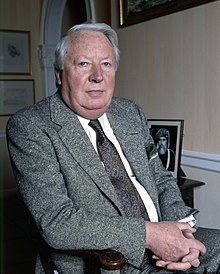Said bin Taimur
This article needs additional citations for verification. (April 2009) |
| Said bin Taimur | |
|---|---|
Al Said | |
| Father | Taimur bin Feisal |
| Mother | Sheikha Fatima bint 'Ali Al-Sa'id |
| Religion | Ibadi Islam |
Said bin Taimur (
He was a member of the
Early life and education
Said was born in 1910.[1] He attended Mayo College at Ajmer in Rajputana, India, from 1922–1927 where he mastered English and Urdu. Upon his return to Muscat in May 1927, it was suggested he attend Beirut to further his education. His father, Sultan Taimur bin Feisal, feared that by sending him to Beirut, he would be influenced by Christianity.[2]
Said’s father was strongly against him learning the ways of the Western world and speaking English. When Said was younger, his father found Sa’id and his brother Nadir possessing an English primer, and he ordered all their books be burned. Instead of sending Said to Beirut, his father sent him to Baghdad to study Arabic literature and history for a year.[2]
Early political career
After completing his year-long study in
Marriages and children
Said's married his first wife, a Dhofari woman from the Al Mashani family, in 1933[4]..
- Sayyida Umaima bint Said bin Taimur Al Said
In 1936, Said married his second wife, Mazoon bint Ahmad bin Ali Al Mashani, who was a cousin of his first wife.[4]
- Sultan Qaboos bin Said bin Taimur Al Said (born 18 November 1940)
He also had a daughter by a concubine.[4]
- Sayyida Khadija bint Said bin Taimur Al Said
Reign
Accession
On his accession, he inherited the remains of the
Foreign affairs
Once he became Sultan, Said maintained a friendly relationship with the
During
Leadership
Oil wealth would have allowed Said to modernize his country. He secured British recognition of its independence in 1951. Nevertheless, he also faced serious internal opposition, from Imam
In 1958 Said sold Gwadar to Pakistan for $1 million, while in 1967 Britain returned the Khuriya Muriya Islands.
Said became more reclusive from his people and country. In 1965, after making concessions to export oil with Iraq, Iran and Britain, he did little to improve the life of his people. The benefits of this deal would not come to fruition until his was deposed in 1970 in a palace coup.
In 1965, the province of
Before he was overthrown in 1970, because of his backwards policies, Oman had an under 5 mortality rate of around 25%.
Deposition

Qaboos returned from his educational studies in the United Kingdom at the Royal Military Academy, and a year of service in the British Army infantry in 1964, and was placed under house arrest.[8] Said did not speak to his son during the last 14 months before the coup, even though they lived in the same palace.[citation needed]
On 23 July 1970 at the Sultan’s palace in
Honours
- Hon. Knight Grand Commander of the Order of the Indian Empire (GCIE: 1 January 1945; Hon. KCIE: 30 March 1938)[11]
- Hon. Knight Grand Cross of the Order of St. Michael and St. George (GCMG): 1965
Ancestry
| Ancestors of Said bin Taimur | |||||||||||||||||||||||||||||||||||||||||||||||||||||||||||||||||||||||||||||||||||||||||||||||||||||||||||||||||||||||||||||||||||||||||||||||||||||||||||||||||||||||||||||||||||||||||||||||||||||||||||||||||||||||||||||||||||||||||||||||||||||||||||||||||||
|---|---|---|---|---|---|---|---|---|---|---|---|---|---|---|---|---|---|---|---|---|---|---|---|---|---|---|---|---|---|---|---|---|---|---|---|---|---|---|---|---|---|---|---|---|---|---|---|---|---|---|---|---|---|---|---|---|---|---|---|---|---|---|---|---|---|---|---|---|---|---|---|---|---|---|---|---|---|---|---|---|---|---|---|---|---|---|---|---|---|---|---|---|---|---|---|---|---|---|---|---|---|---|---|---|---|---|---|---|---|---|---|---|---|---|---|---|---|---|---|---|---|---|---|---|---|---|---|---|---|---|---|---|---|---|---|---|---|---|---|---|---|---|---|---|---|---|---|---|---|---|---|---|---|---|---|---|---|---|---|---|---|---|---|---|---|---|---|---|---|---|---|---|---|---|---|---|---|---|---|---|---|---|---|---|---|---|---|---|---|---|---|---|---|---|---|---|---|---|---|---|---|---|---|---|---|---|---|---|---|---|---|---|---|---|---|---|---|---|---|---|---|---|---|---|---|---|---|---|---|---|---|---|---|---|---|---|---|---|---|---|---|---|---|---|---|---|---|---|---|---|---|---|---|---|---|---|---|---|---|
| |||||||||||||||||||||||||||||||||||||||||||||||||||||||||||||||||||||||||||||||||||||||||||||||||||||||||||||||||||||||||||||||||||||||||||||||||||||||||||||||||||||||||||||||||||||||||||||||||||||||||||||||||||||||||||||||||||||||||||||||||||||||||||||||||||
References
- ^ Michael Quentin Morton (2013). "Thesiger And The Oilmen: A Dilemma Of Oil Exploration In Southern Arabia, 1930–1955" (PDF). Oil Industry History. 14 (1): 1–14.[dead link]
- ^ a b c d Phillips, Wendell (1966). Unknown Oman. David McKay Company, Inc. New York. p. 19.
- ^ a b Rabi, Uzi (2011). The Emergence of States in a Tribal Society: Oman Under Said Bin Taymur, 1932-1970. Apollo Books. p. 48.
- ^ ISBN 0850110297.
- ^ Curtis, Mark (1998). The Great Deception: Anglo-American Power and World Order. London: Pluto Press. p. 21.
- ^ Hill A.G., Muyeed A.Z., al-Lawati J.A., (editors). The Mortality and Health Transitions in Oman: Patterns and Processes. WHO Regional Office for the Eastern Mediterranean and UNICEF, Oman. Muscat 2000.
- ^ Cleveland, Bunton, William L, Martin (2013). A History of the Modern Middle East. Boulder, CO: Westview Press. pp. 409–410.
{{cite book}}: CS1 maint: multiple names: authors list (link) - ^ Jones, Ridout, Jeremy, Nicholas (2015). A History of Modern Oman. Cambridge University Press. p. 146.
{{cite book}}: CS1 maint: multiple names: authors list (link) - ^ Gold, frankincense and mirth in deepest Arabia | Travel | The Observer
- ISBN 1-85367-567-9, page 29.
- ^ The India Office and Burma Office List: 1947. HM Stationery Office. 1947. p. 96.
Sources
- Harris M. Lentz III, Heads of States and Governments: A Worldwide Encyclopedia of Over 2,300 Leaders, 1945 through 1992. McFarland & Company, Inc., 1994, p. 604. ISBN 0-89950-926-6.

